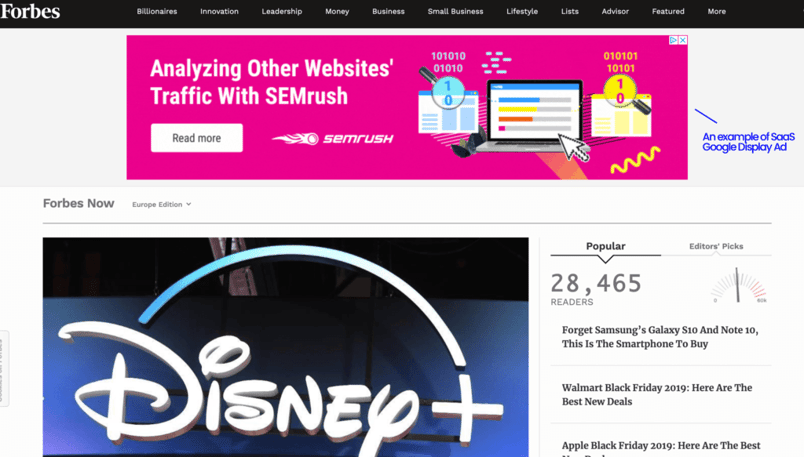The SaaS industry is experiencing rapid growth with an estimated valuation of $195 billion by 2024. According to Blissfully’s “Annual 2019 SaaS Trends Report“, the average company spends $343K per year on SaaS products, representing a 78% increase from 2018. Right now, SaaS companies seem to be everywhere and most of us are using their products daily. This may sound great on paper for all SaaS marketers and executives.
However, as the popularity of the industry rises, so the competition becomes more intense. CPCs bids for most software-related keywords are expensive and the cost per acquisition is high, especially at the start. And if you are a SaaS startup with a tight budget and not enough data about your customers, using Google Ads may result in a costly experiment without bringing in any real result.
Despite that, Google Ads campaigns have the potential to be one of the most powerful marketing tools at your disposal. They boost website traffic, increase conversion rates and help to keep your ad spend under control. If used correctly, they can grow into a powerful customer acquisition tool for your business.
In this article, we're bringing you 5 useful Google Ads tips for SaaS to attract more paying customers and drive consistent growth.
Bid on Problem & Solution Keywords
Create ads that provide solutions to your customer's problems. Instead of going for high-volume keywords that are naturally more competitive and expensive, focus on more specific, long-tail keywords to deliver a highly relevant experience for your visitors.

To craft a solution-centred ad, you have to know your buyer persona first. What are the pain points of your customers and how does your product solve them? We use the pillar's analogy to get the full picture of our buyer persona and to choose the PPC keywords most effectively. Next, group the keywords in ad groups with different problems and direct them to your ad offering the solution.
Once the visitors arrive at your landing page, they'll get access to an educational piece of content (such as eBook or a webinar) in exchange for their contact information. Providing your audience with relevant content builds trust and familiarity. It also validates your offer, so when the time comes (based on the length of your sales cycle), the customers will be more inclined to make a purchase.
Choose the Right Metric
Hint: It's the customer lifetime value, not cost per acquisition/cost per click. For example, let's say your product is priced at $89 per month and the cost of acquiring a customer goes over $200. Is your campaign a failure? Not necessarily. If the customer renews his subscription for at least three consecutive months, you made a profit.
Therefore, it's important to determine your ad spend based on the lifetime value of the acquired customer, not on how much it costs to get that customer. To further understand this, you also have to consider the average churn rates. A positive churn rate for SaaS companies is 3-5% monthly. This means that for every 100 subscribers, 3-5 of them don't renew at the end of the month.

Each new customer would then have a lifespan of 20 to 33 months. Based on this calculation and your product being priced at $89 per month, every newly acquired customer is worth at least $1780. The key takeaway? Don't write off your campaigns just because the CPC of the keywords you would like to target seems too high. Chances are, if your churn rates are in a reasonable range, your return on ad spend will still be positive.
Utilise Google Display Network
Search network campaigns are expensive with some of the common SaaS keywords attracting massive CPC bids going well over $100. One way to work around this is to use the Google Display Network. It's made up of millions of websites giving your campaign huge potential reach and more visibility at a better price than you'd pay for traffic coming from Google search.
This makes it a great tool for promoting brand awareness while staying at top-of-mind for potential customers. GDN is also suitable for running an effective remarketing campaign. Remarketing allows you to show ads to your previous website visitors with a simple goal: encourage them to return and convert. Plus, unlike text-only ads on the Google search network, display ads are image and video-based which makes them more visually appealing.

The biggest advantage of GDN is that you pay much less for similar (or even bigger) exposure than you would if you used paid search.
The main downside of GDN is that many of the people who view your ads won't even notice them. You also have no control of ad display as Google doesn't always match ads with relevant websites. So while GDN is great for boosting brand awareness and remarketing, Google search is a better fit if conversions are your main goal.
Use Similar Audiences to Boost Reach
Lookalike audiences work like this: Google tracks the visitors who perform a search for a product like yours or are similar to one of your existing audiences. You can then tap into the data and use the option to target these users. All you need to do is to add a similar audience targeting to your campaign.
Similar audiences are effective because they only target new users that are likely to be interested in your product. They are easy to manage and improve both your reach and conversion rates (especially in combination with display remarketing).
Target Competitor Keywords
The main benefit of this strategy is that you are targeting people who already showed intent in a product like yours. They understand the need for the software you offer and are ready to buy (or at least to sign up for a free trial). Start by targeting your competitor's brand name plus a related keyword and craft ad copy around weaknesses. Highlight what about your offer makes your product a better alternative.
Then, take the visitors to the landing page where you clearly explain the main benefits of your product over theirs (for example, by creating a side-by-side comparison). Make sure to create a landing page that matches the offer and messaging on your ad to avoid users bouncing back to the search page.
While competitor targeting can be a goldmine for customer acquisition, proceed with caution. It can open you up to a bidding war and inflate the CPC. You also need to respect Google rules to avoid being reported for the use of the trademarked brand name in your ad text/display URLs.
Tip: Our favourite tool for competition targeting is SEMRush. It helps us to perform detailed competitor analysis and do robust and accurate keyword research.
Conclusion
Google Ads take time to master. But it's entirely possible to gain more customers, increase brand awareness and produce a constant flow of warm leads while keeping your ad spend under control. All you need is a well-thought-out approach. Start with these 5 tips and see how your results improve.
BIAS is an award-winning digital agency specialising in Inbound Marketing. Need support with an upcoming PPC campaign? Let’s chat.

%20small.jpg)


